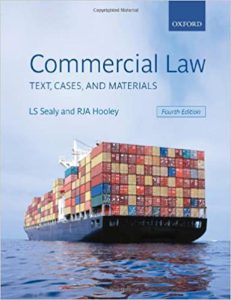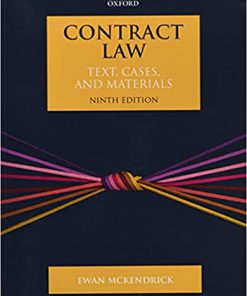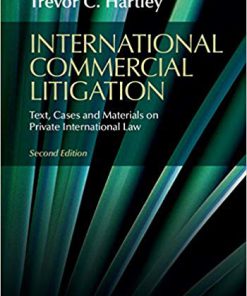(eBook PDF) Commercial Law: Text, Cases, and Materials 4th Edition
$50.00 Original price was: $50.00.$35.00Current price is: $35.00.
(eBook PDF) Commercial Law: Text, Cases, and Materials 4th Edition – Instant Download
(eBook PDF) Commercial Law: Text, Cases, and Materials 4th Edition – Digital Ebook – Instant Delivery Download

Product details:
- ISBN-10 : 019929903X
- ISBN-13 : 978-0199299034
- Author: S Sealy
Commercial Law: Text Cases and Materials has been an indispensable and hugely popular resource for students of law and business management for over ten years. Combining extracts from cases and other materials with substantial commentary and explanatory text, Sealy and Hooley provide context for the extracts, question their significance, and provide an authoritative guide to commercial law.
This book follows a very clear structure, discussing topics covered on commercial law courses not as separate entities, but as part of a coherent whole, enabling students to easily make links between different areas of the law. Fundamental concepts such as ownership, possession, and good faith run through the book, offering common themes connecting each area. The authors supply extensive commentary on key decisions, helping students to focus on the most important areas; also provided are European and American examples, ensuring that students have access to a comparative analysis of commercial law as it operates throughout the world.
Table contents:
Part I Introduction
1 An introduction to commercial law
1 The nature of commercial law
2 The function of commercial law
3 The historical development of commercial law
4 The sources of commercial law
5 The role of equity in commercial law
6 Public law in the commercial arena
7 The philosophy and concepts of commercial law
8 The codification of commercial law
9 The challenges for commercial law in the twenty-first century
10 The impact of Brexit on English commercial law
2 Basic concepts of personal property
1 The distinction between real and personal property
2 Types of personal property
3 What is property?
4 What are the characteristics of property rights?
5 The significance of property rights
6 Types of property rights in chattels
7 Ownership of chattels
8 Acquisition and transfer of legal and equitable ownership in chattels
9 Possession of chattels
10 The protection of possession
11 Attornment in respect of chattels
12 Transfer of possession
13 The importance of possession
14 Acquisition and transfer of legal and equitable ownership in choses in action and intangibles
15 The remedies for recovery of, and interference with, personal property
16 Equitable property
3 Bailment
1 What is bailment?
2 Types of bailment
3 Three requirements for a bailment
4 The bailee’s liability
5 The burden of proof
6 Bailment and third parties
Part II The Law of Agency
4 Introduction
1 The legal concept of agency
5 Creation of agency, and the authority of the agent
1 Creation of the agency relationship
2 Authority of the agent
6 Relations with third parties
1 Disclosed agency
2 Undisclosed agency
7 Relations between principal and agent
1 Duties of the agent
2 Rights of the agent
3 Termination of agency
Part III Domestic Sales Law
8 Introduction and definitions
1 Introduction
2 The Sale of Goods Act and the general law
3 The application of the Sale of Goods Act
4 Definitions
5 Sale of goods distinguished from other transactions
6 Formation of the contract of sale
9 Passing of the property in the goods as between seller and buyer
1 Significance of the passing of property
2 Rules for determining when the property passes
3 Passing of property, acceptance, and rejection
4 Risk and property
5 Statutory provisions relating to perishing of specific goods
6 Frustration of sale of goods contracts
10 Transfer of title
1 The rule nemo dat quod non habet
2 First exception: estoppel
3 Second exception: sale under the Factors Act 1889, s 2
4 Third exception: sale under a voidable title
5 Fourth exception: sale by seller continuing in possession
6 Fifth exception: sale by buyer in possession
7 Sixth exception: sale by unpaid seller under SGA 1979, s 48
8 Seventh exception: private purchase of motor vehicle held on hire-purchase
9 Eighth exception: sale under general powers of sale or court order
11 Seller’s obligations as to quality
1 Introduction: express and implied terms as to quality, and their effect
2 The implied condition that the goods will correspond with their description (s 13)
3 Implied terms as to quality and fitness in general
4 The implied condition that goods are of satisfactory quality (s 14(2))
5 The implied condition as to fitness for purpose (s 14(3))
6 Terms implied in sales of goods by sample (s 15)
7 Contractual modification of the seller’s obligations as to quality
8 Product liability
12 Performance of the contract
1 Duties of the seller
2 Duties of the buyer
13 Remedies of the seller
1 Action for the price
2 Action for damages for non-acceptance
3 Recovery or forfeiture of a deposit
4 Specific performance
5 Remedies of an unpaid seller against the goods: lien, stoppage in transit, and resale
6 Retention of title clauses
14 Remedies of the buyer
1 Introduction
2 The buyer’s action for damages for non-delivery
3 The buyer’s action for damages for late delivery
4 The buyer’s action for damages for breach of warranty
5 The buyer’s right to recover the price of goods not delivered, or validly rejected
6 Specific performance
Part IV International Sales
15 International sales
1 Introduction
2 Typical export transactions and INCOTERMS
3 Sales involving sea carriage
4 FOB contracts
5 FAS contracts
6 CIF contracts
7 Variants of the CIF contract
8 DAP contracts (sometimes called ‘ex ship’ or ‘arrival’ contracts)
9 FCA, CIP, and similar contracts
10 International sales: the future
Part V Payment Methods
16 Modern payment systems
1 Introduction
2 The nature of a funds transfer
3 Terminology
4 Credit/debit transfers
5 Clearing and settlement
6 Clearing systems and clearing rules
7 Duties of the banks involved in a funds transfer
8 Countermand
9 Completion of payment
10 Unwanted payments
17 Payment cards and electronic money
1 Introduction
2 Types of payment card
3 Contractual networks
4 Liability for unauthorised transactions
5 Connected lender liability
18 Negotiable instruments
1 Introduction
2 Definition of a negotiable instrument
3 How instruments come to be negotiable
4 Types of negotiable instrument
5 Advantages of a negotiable instrument
19 Bills of exchange
1 The use of bills of exchange
2 The Bills of Exchange Act 1882
3 Definition of a bill of exchange
4 Transfer of a bill of exchange
5 Persons entitled to the benefit of the obligation on the bill
6 Liability on the bill of exchange: general principles
7 Liability on the bill: specific parties
8 Enforcement of the bill
9 Discharge of the bill
10 Mistaken payment
20 Cheques and miscellaneous payment instruments
1 Cheques
2 Banker’s drafts
3 Travellers’ cheques
Part VI The Financing of International Trade
21 The financing of international trade
1 Documentary bills
2 Documentary credits
3 Standby credits, performance bonds, and guarantees
4 Other financing methods
5 Export credit guarantees
Part VII Assignment and Receivables Financing
22 Assignment of choses in action
1 Introduction
2 ‘Chose in action’ and ‘assignment’
3 Existing and assignable choses in action
4 Intention to assign
5 Writing
6 Notice
7 Effects of assignment
8 Obstacles to enforcement
23 Receivables financing
1 General introduction
2 Financing by sale
3 Financing by secured transactions
4 Other doctrines affecting assigned receivables
5 Reform
6 International factoring
Part VIII Commercial Credit and Security
24 Introduction
1 Commercial credit
2 Security
25 Possessory security
1 Pledge
2 Lien
3 Reform
26 Non-possessory security
1 Mortgage
2 Equitable charge
3 Equitable lien
4 Statutory control
5 Reform
Part IX Principles of Insurance Law
27 Insurance
1 Introduction
2 Formation of the contract
3 Content and interpretation of the contract
4 Liability of the insurer
5 Rights of the insurer
6 Marine insurance
7 Insurance claims
Part X Insolvency Law
28 Insolvency
1 Introduction
2 The basic objectives of insolvency law
3 The various definitions of insolvency
4 Insolvency procedures
Index
People also search:
criminal law cases and materials 4th edition pdf
commercial law text cases and materials pdf download
You may also like…
Ebook-PDF
(eBook PDF) Equity & Trusts: Text, Cases, & Materials (Text, Cases, and Materials) 3rd Edition












